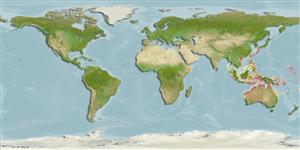Common names from other countries
Teleostei (teleosts) >
Siluriformes (Catfishes) >
Plotosidae (Eeltail catfishes)
Etymology: Paraplotosus: Greek, para = in the side of + Greek, plotos = swimming (Ref. 45335); butleri: Named in honor of W. 'Harry' Butler, who assisted in with the collection of many of the paratypes (Ref. 31103).
Environment: milieu / climate zone / depth range / distribution range
Ecology
Marine; reef-associated; depth range 0 - 5 m (Ref. 31103). Tropical
Indo-West Pacific: northern Australia.
Size / Weight / Age
Maturity: Lm ? range ? - ? cm
Max length : 32.5 cm SL male/unsexed; (Ref. 31103)
Short description
Morphology | Morphometrics
Dorsal
spines
(total): 1;
Dorsal
soft rays
(total): 115-130;
Anal
spines: 0;
Anal
soft rays: 87 - 102. Differs from Paraplotosus albilabris and P. muelleri in having a tall, sail-like first dorsal fin and extremely long nasal barbels, which extend posteriorly to the basal third of the pectoral fin or beyond (Ref. 31103). Small juveniles have a unique coloration consisting of a black head and body with a broad white to yellow margin on the first dorsal fin and continuous dorsal-caudal-anal fin (Ref. 31103). Adults entirely black (Ref. 31103).
Restricted to coastal reefs (Ref. 31103). Secretive, found in reef holes or under large rocks (Ref. 31103). Presumably nocturnal (Ref. 31103). Feeds on gastropod mollusks and crustaceans (Ref. 31103).
Life cycle and mating behavior
Maturity | Reproduction | Spawning | Eggs | Fecundity | Larvae
Allen, G.R., 1998. A review of the marine catfish genus Paraplotosus (Plotosidae) with the description of a new species from north-western Australia. Raf. Bull. Zool. 46(1):123-134. (Ref. 31103)
IUCN Red List Status (Ref. 130435)
CITES (Ref. 128078)
Not Evaluated
Threat to humans
Harmless
Human uses
More information
Common namesSynonymsMetabolismPredatorsEcotoxicologyReproductionMaturitySpawningFecundityEggsEgg development
Age/SizeGrowthLength-weightLength-lengthLength-frequenciesMorphometricsMorphologyLarvaeLarval dynamicsRecruitmentAbundance
ReferencesAquacultureAquaculture profileStrainsGeneticsElectrophoresesHeritabilityDiseasesProcessingMass conversion
Tools
Special reports
Download XML
Internet sources
Estimates based on models
Preferred temperature (Ref.
115969): 24.4 - 29.2, mean 28.3 (based on 1313 cells).
Phylogenetic diversity index (Ref.
82804): PD
50 = 0.6250 [Uniqueness, from 0.5 = low to 2.0 = high].
Bayesian length-weight: a=0.00457 (0.00199 - 0.01049), b=3.07 (2.86 - 3.28), in cm Total Length, based on LWR estimates for this (Sub)family-body shape (Ref.
93245).
Trophic level (Ref.
69278): 3.4 ±0.54 se; based on food items.
Resilience (Ref.
120179): High, minimum population doubling time less than 15 months (Preliminary K or Fecundity.).
Fishing Vulnerability (Ref.
59153): Low to moderate vulnerability (30 of 100).
